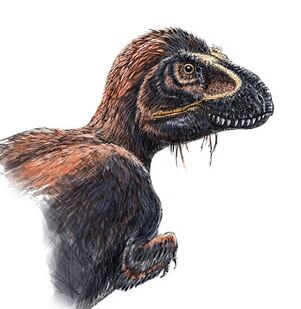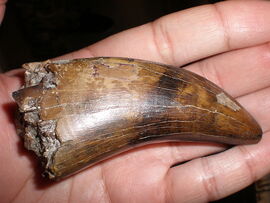
Tyrannosaurus rex may of had an infectious bite.
'Some dinosaurs had venom or an infectious bite,' like that of snakes and the Komodo dragon. This is possible that some dinosaurs may of had this but more specimens may be needed.
Infectious Bite in the genus Tyrannosaurus[]
Tyrannosaurus may of had infectious saliva used to kill its prey. This hypothesis was first mentioned in William L. Abler's publicated essay called The Teeth of the Tyrannosaurs [1]. He based this conclusion by looking at the teeth of T. rex and he could see in between each serration is a "deep mark". These "marks" may of held in pieces of carcass loaded with bacteria giving Tyrannosaurus a deadly, infectious bite.
If it did have this infectious bite it would take some time to effect the prey. A fossil of an Edmontosaurus has got a healed bite of Tyrannosaurus on it [2]. Maybe some T. rexs didn't have the infectious bite or maybe it was just the adults that had it.

This is the fossilized remains of a partial Tyrannosaurus rex tooth. If you zoom in on this image (click on the image) you can see the tiny serrations on the top right part of the tooth. These serrations may have been the key to T. rex's infectious saliva.
In Popular Culture[]
- In the series Jurassic Fight Club [3], Episode 2 (T. Rex Hunter), Tyrannosaurus was portrayed with this killer bite.
- On the miniseries Clash of the Dinosaurs it mentioned it was possible Tyrannosaurus had an infectious bite.
- In many books it discusses the possibility of Tyrannosaurus have a bacterial-filled bite. In one of them, The Complete T. Rex, by John R. Horner [4], it briefly describes the theory of the infectious bite by William Abler.
Venom in the genus Sinornithosaurus[]
In 2009, a team of scientists lead by Enpu Gong examined a well-preserved Sinornithosaurus skull, and noted several features suggesting it was the first-identified venomous dinosaur. Gong and colleagues noted that the unusually long and fang-like mid-jaw (maxillary) teeth had prominent grooves running down the outer surface, towards the rear of the tooth, a feature seen only in venomous animals. They also interpreted a cavity in the jaw bone just above these teeth as the possible site for the soft-tissue venom gland. [7]

This is an illustration of Sinornithosaurus's skull. The red arrow points to the possible venom gland.
Gong and colleagues suggested that these unique features indicated that Sinornithosaurus may have specialized in hunting small prey such as birds, using its long fangs to penetrate feathers and envenomate and stun the prey, like a modern snake. They also suggested that the short, slightly forward-pointing teeth at the tip of the jaw could have been used to strip feathers from birds.[8]